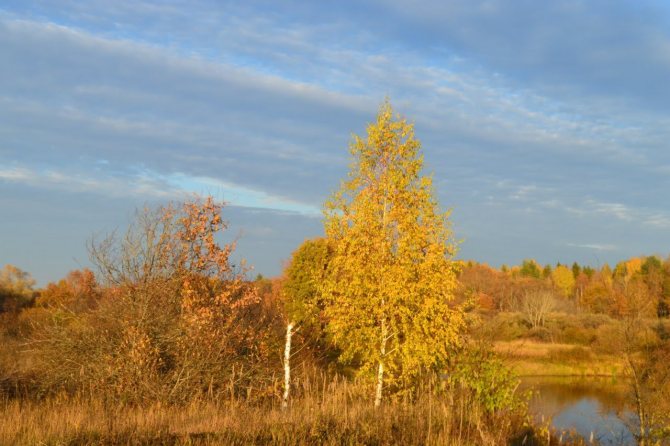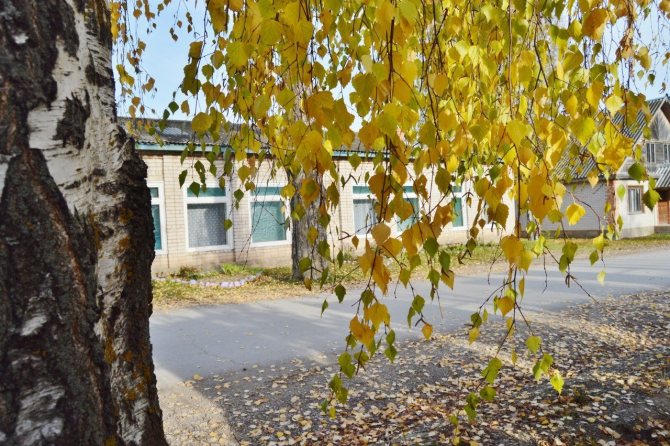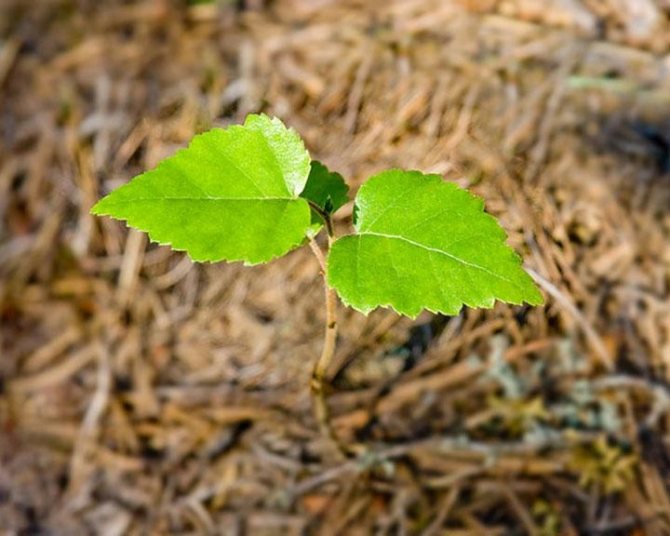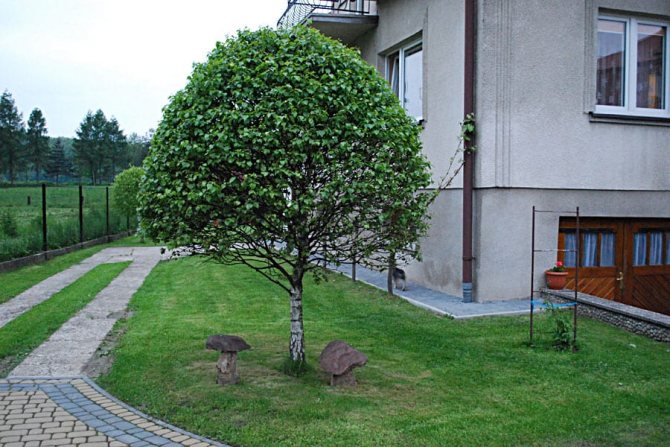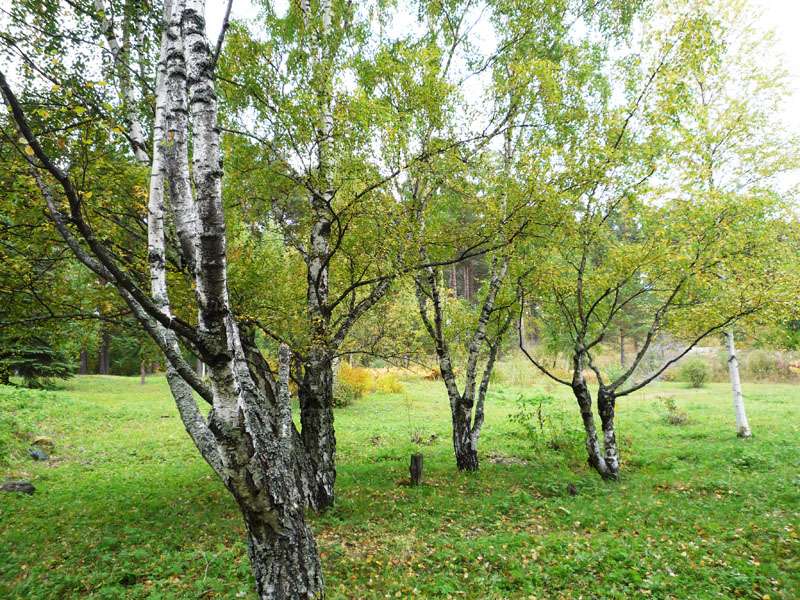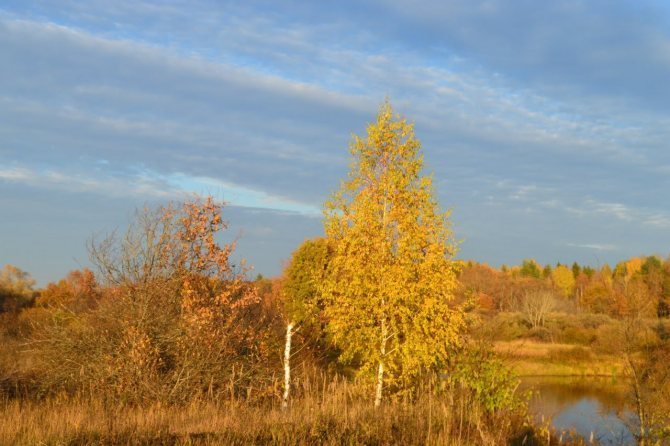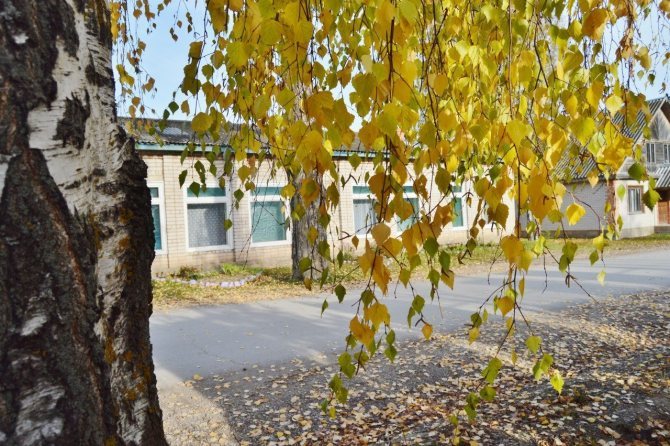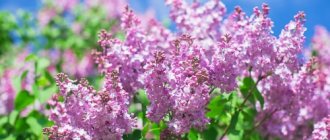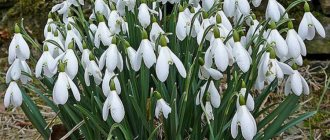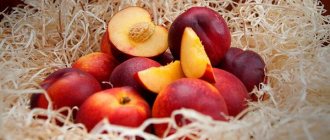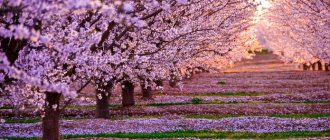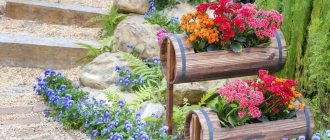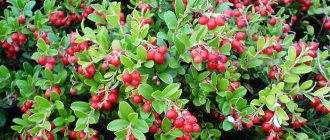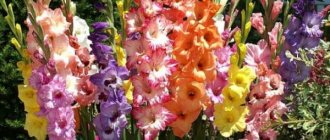Birch is considered a symbol of our country. This is one of the most beautiful and unpretentious tree species. That is why it is more often chosen for planting in a summer cottage, or in a gazebo next to the house. Despite the unpretentiousness, the planted seedling requires proper care at first. There are some peculiarities and rules when planting a tree in the autumn or spring season.
Important! Before planting, it should be noted that the tree can grow up to 8 m wide, taking into account the crown. Therefore, you need to correlate the distance between it and the nearest building.
The age of the seedling should not exceed seven years, otherwise it will be difficult to take root in the new soil.
Birch: planting and care in the open field
It is best to plant in places where there is little shade, as the tree loves moisture. The presence of penumbra contributes to less evaporation and retention of moisture in the soil. At the same time, there must be adequate lighting.
Attention! Here you will find all the most interesting and useful about birches.
After deciding on the location, we make a depression in the soil so that the root collar of the plant is close to the surface of the earth. If this moment is not taken into account, then the birch may die. An adult tree does not like to cover the roots with soil.
Slightly acidic, loose humus is ideal as a soil. The use of fertilizers in the form of a mixture of soil and humus during planting is encouraged. Evening time is best for the tree to take root.
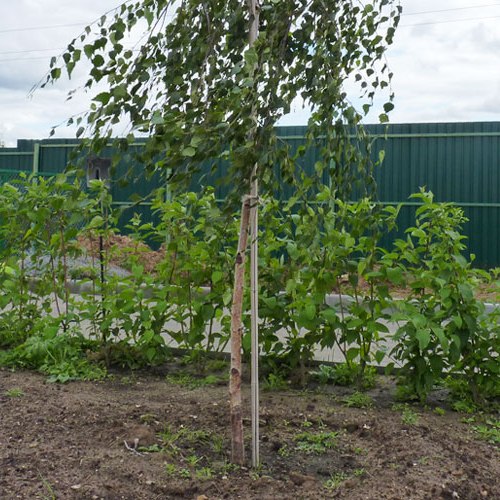
The seedling, in the first days after planting, should be covered with branches from the sun. For the first 4 days, the tree needs abundant watering. Care must be taken to keep the soil constantly moist. On the following days, watering is done as needed.
Saplings
Saplings are grown from seeds, shoots, dug up in the forest or bought from a nursery.
Sapling from seed
Birch propagates by seeds. In nature, the process occurs naturally. Growing birch at home is difficult.
In the fall, the ripe seeds are harvested. To do this, cut off the shoots, tie them into a bunch, and hang them in a dry place. The final ripening of the seeds takes place during the week. Then they are shaken out of the earrings, sifted out of unnecessary litter.
Planting is carried out in the year of collection. Seeds are added in the fall or early winter.
The site for planting is preliminarily prepared: the earth is dug to a depth of 25–35 cm, weeds, large roots are removed, the soil is treated with antifungal agents. Weeds are weeded until the seeds are planted.
Sprouted birch must be protected from shading.
The final preparation stage begins ten days before sowing. At this time, the soil is leveled, holes are made 5 cm deep, 10 cm in diameter at a distance of 35–40 cm from each other. Sowing begins in calm evening hours.
Each hole is fertilized with a two-millimeter layer of humus, covered with loose soft soil.
In the first weeks after spring germination, birch is vulnerable. At this time, you need to organize abundant watering. Use a spray gun at a frequency so that the top of the soil does not dry out. The roots of the plant at this stage are at a depth of only about 10 cm. Abundant watering is provided until mid-August. In summer, seedlings begin to grow actively only from mid-July, by the end of the season they reach 20-30 cm in height
... The largest specimens can be planted in a permanent place in the fall. The rest must be moved to a nursery - a specially prepared and fertilized place. Seedlings are arranged in rows. Placed at a distance of at least 10 cm from each other. When birches reach a height of 50–80 cm, in the fall of next year, they are planted in a permanent place.
Cuttings sapling
The method is rarely used: shoots take root poorly.
On an adult birch, a young, already formed cutting with a length of 40-60 cm is chosen. It is carefully trimmed and placed in a mixture of water and a root formation stimulator. Then they are transferred to a room with a temperature of about 25 ° C.
After the roots appear, the cutting is planted in a large flower pot.
... They organize abundant and frequent watering (2-3 times a day), prevent the land from drying out, apply fertilizers. After 2-3 weeks, the seedling takes root. It is carefully removed from the pot along with the soil, transplanted to a permanent place.
How to choose a seedling in the forest
A young birch hike is best done in early spring, before the leaves bloom on the trees. You can take a seedling in the forest in the fall, but it may die, not take root after transplanting.
Choose a healthy birch with a height of 80 to 100 cm, without twisted, twisted branches, traces of diseases on the bark.
If the birch was transported from the forest, then a complex fertilizer is added to the hole.
The tree is carefully dug around, from three sides they go deep into the ground with a shovel, and the seedling is taken out of the ground. Do not shake off the roots so that they do not dry out. The seedling is placed in a bucket or bag, sprinkled with soil.
Planting birch in autumn
In the autumn, planting is carried out after the leaves on other trees have begun to fall. The ideal time for planting is late September and October. The tree must have time to take root before the first frost and take root. Pay attention to the root of the seedling - it should not be naked or damaged. If you plant a birch in the fall, then in the spring it will be able to give new roots.
Planting rules in autumn
A hole is dug, meter by meter, a little loose earth is poured onto the bottom. Then the seedling is placed in a recess, filled with water and sprinkled with soil.
Important! Use a garter as a strong wind will cause the seedling to sway and the roots will not be able to take root in the ground.
During the autumn planting, phosphate fertilizers are used. They are aimed at strengthening the root system and its development. It is not recommended to use manure or nitrogen fertilizers as fertilizer.


Work order
This requires a professional approach so that no marks (scratches or cuts) remain on the bark. Any violation of the trunk cover is fraught with the death of the plant or the development of various diseases, which means that arborists should work here - specialists in the maintenance and care of trees.
The step-by-step process of crowning is as follows:
- With the help of a large slingshot, the arborist throws the rope to the top of the tree.
- Carefully climbs up and cuts off unnecessary branches or the whole top in order to shorten the tree to the desired length.
- If there is no place under the tree to throw the cut branches down, they are tied up with a rope (hung and slowly lowered down).
Correct pruning of birch means that the arborist has cut the right branch in the right place exactly as the rules require - not too short for the trunk to split, but not too far from the trunk for the "wound" to heal quickly. Our certified craftsmen will help you do this work without consequences. How much it costs to prune birch can be found here.


Pruning birch is a procedure that is as necessary for a plant as loosening the soil.If you do this correctly, the tree will look neat, harmoniously complementing the landscape design of the site.
Planting birch in spring
If you decide to plant a tree in the spring, then it is important to do this in the early period, before budding on the trees.
A clay talker is made for the roots of the seedlings. To do this, take clay and dilute it in water to a consistency of not thick sour cream. The root is dipped in the resulting solution and placed in the planting hole. Before that, you should pour a bucket of water into the hole.
Remember! The neck of the root must not be buried. Otherwise, the tree will die.
The pit is gradually filled up, trampling the soil a little. When the root of the seedling is in the ground and the soil around is compacted, the tree is tied to a peg and watered with several buckets of water. At first, you should monitor the looseness of the soil near the trunk so that moisture can penetrate to the roots. In springtime, the tree can be fed with nitrogen fertilizers.
Let's summarize
White-barrel beauties grow everywhere and delight us both in summer and winter. Trees with uncut crown look dignified and natural in their environment - in the forest. But trees growing in gardens and orchards often need to edit the crown. So when to prune birch trees:
- sanitary - done to remove sick, broken and interfering branches. This pruning is best done in early spring;
- anti-aging - needed to refresh the look of the tree and stimulate the growth of new shoots. Better to spend in spring or autumn;
- restriction of growth - it is better to do pruning in the summer season;
- decorative haircut - to give an original shape - is carried out in spring or autumn. In no case in the spring, otherwise the tree will die.
Some types of birches and features of caring for them
There are over a hundred different types of birch trees. Many species share common characteristics and average heights between 15 and 20 m.
Common types that are most often chosen for planting outdoors are:
- white-trunk birch;
- drooping birch;
- paper birch;
- cabin boy's birch;
- Japanese birch.
The listed species do not require special care and are unpretentious to the ground, capable of taking root on almost any wet soil. Saplings should be purchased with a good earthy clod. Trees with a bare root system do not take root well.
It is interesting! If you want to use birch sap for treatment, then read about contraindications for use here.
Despite the fact that birch trees can take root in soil with a poor nutrient content, it is recommended to fertilize the soil. After planting, mulching can be done. Not only does it look pretty, but it also helps regulate soil temperature.
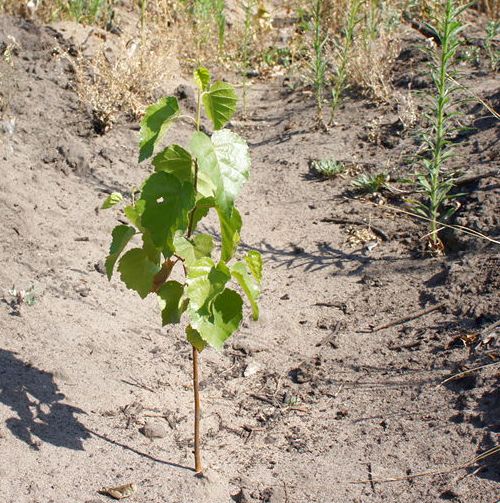

Suitable for mulching:
- wood chips;
- chopped bark;
- peat;
- leaves;
- crushed stone.
Each type of mulch material has its own characteristics and can be used at the discretion of the gardener. For example, mulch from leaves or peat in the process of humus creates a special layer of soil that improves oxygen exchange and retains moisture. Crushed stone mulch does not possess such properties, and is used only for aesthetic purposes.
For prophylaxis in the fight against harmful insects (bear, May beetles, etc.), special agents such as fungicides and insecticides should be used.
Diseases associated with fungal organisms are the first enemies of birches, which destroy birches from the inside. Drone mushrooms are the most dangerous and should be removed immediately.
Attention! This article will tell you about the correct use of birch bud tincture.
Pros and cons of birch plantings around the house
When decorating a backyard area, it is very important to pay attention not only to what grows around the house, but also the characteristics of the state of the soil, as well as the features of the relief of the adjacent landscape.In order for the decorative planting next to the house to look as effective as possible, you also need to focus on the exactingness of the planted culture and the purpose in the garden landscape.
Planting a young birch tree in a backyard decor looks very attractive, especially in summer and autumn, but have both certain pluses and some minuses:
- a festive look with white trunks and an openwork crown allows you to visually expand the space of even very small areas;
- the high crown of an adult tree gives a light and sliding shade that is not dangerous for the growth and development of other plants;
- birch is a source of very valuable plant raw materials, and also energizes a person and helps to get rid of stress;
- if the land on the site is too wet, then the birch roots are able to drain the area quickly and efficiently;
- even a plant transplanted from the forest takes root very quickly and without problems in the backyard.
The inconvenience of growing can be attributed to the difficulty of obtaining a beautiful lawn coverage in the projection of the crown. The fact is that the birch root system is capable of harming crops that grow in close proximity, taking away moisture and nutrients from them. Therefore, in order to properly plant any plants under the crown of these trees or a few meters from them, you need to pay special attention to high-quality soil preparation and irrigation measures.
Crown pruning
Trimming the crown of a birch frees the tree from dried branches and improves the aesthetic appearance of the tree. Pruning may be necessary in case of strong growth, when branches become an obstacle to nearby buildings. Pruning is also carried out in the event of aging to stimulate the growth of new branches. The procedure should be carried out in late autumn or winter.
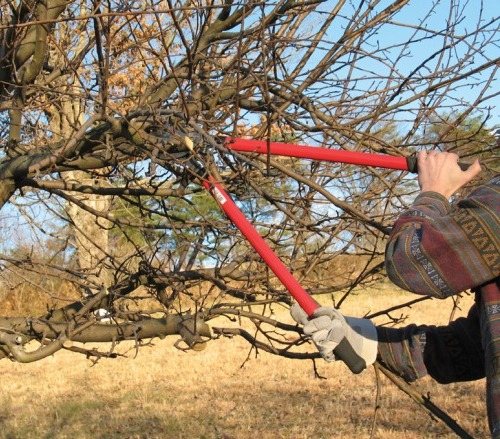

Since it is extremely difficult for a tree to endure pruning, it is better to entrust this matter to specialists who understand the characteristics of growth.
Safe cutting and proper care are the key to healthy growth and development of birch, which will delight with its beauty throughout the years.
Birch is a beautiful tree considered to be a symbol of Russian nature. It has a delicate openwork crown and can reach up to twenty meters in height. The trunk of this tree is covered with a white bark called birch bark, which, like all other parts of the tree, is useful.
Birch loves light, is resistant to high and low temperatures, and is unpretentious. Birches are often used to create city alleys and parks, protective belts, etc. Such trees are planted in places with good access to light. It is better to replant birch at the very beginning of spring. Plants no older than 7 years are suitable for transplantation. Older trees may not take root. Mature trees are planted in the winter with a frozen ball. In the fall, it is undesirable to carry out a transplant. Most of the seedlings die at this time. The distance between planted specimens should not be less than three meters.
When planting birch, a special mixture is used. It includes leafy soil, peat and sand in proportions of 2: 1: 2. It is also recommended to arrange a sand drain of about 15 centimeters. During planting, the plant must be watered. Watering is also needed after about 4 days after planting.
Caring for a birch tree is not difficult. The roots of this tree are located close to the surface of the earth, and therefore, in the dry season, it must be watered regularly.
Fertilize birch at the beginning of spring, before the first leaves appear. Re-fertilization of birch with fertilizers is carried out at the end of spring.
When removing weeds, the soil near the green space must be loosened 3 centimeters deep. Also, the soil around the tree is covered with a protective layer of peat, wood chips. The covering layer should be between 8 and 12 centimeters.
Removal of tree branches in the form of regular pruning is not performed. This is due to the fact that the structure of the crown cannot be disturbed. The only exceptions are dry branches, which are removed in spring.
It is important to protect the tree from diseases and pests. If the leaves are damaged by tube-runner beetles, they are removed and burned. Dig up the soil around the tree. With the invasion of caterpillars, they are shaken off. The tree is treated with insecticides. May beetles can damage tree roots. In this case, the soil is also dug up, and the beetle larvae are destroyed.
Mushrooms that destroy the trunk of a birch must be removed. They can be dangerous for the health and full development of the tree.
Rust prevention is done by spraying the tree with fungicides.
Order services by phone, 8 (926) 133-19-15
So if your backyard is not too spacious, consider watering the soil before planting a birch tree.
Features of tree pruning
Not all gardeners know how to properly prune birch. For example, many are interested in whether it is possible to cut a birch in height. You should learn about the pruning process as much as possible before starting work.
It is worth noting that birch easily tolerates pruning when it is still young. But this process cannot be carried out in the spring, when the process of sap flow occurs. Crown formation is also not worth doing in late autumn.
Pruning is not recommended when seasonal rains begin.
A tree that has been growing on the site for a long time does not tolerate trunks very well.
It is best to prune a birch when it is still at a young age. Then an ugly stump will not form at the very top of the tree. And also in this way you can achieve better health for your seedling, since old and weak branches will be removed.


Pruning should be done only when the tree has grown very much upward. In such cases, quite often branches can cling to wires or become an obstacle to nearby structures.
Pruning is also done if the birch is quite old. In this way, the growth of young branches can be stimulated, and there will be great benefits from this process. Usually, the procedure is carried out in late autumn or already in winter.
Caring for a birch is quite simple, but the most important thing is to find the right place for planting and root the plant. It is this process that must be properly monitored so that the tree does not die.
Things to consider before planting birch
Planting a tree is a decisive step, but you need to think over everything in advance, for several years, or even decades. We plant a birch tree with a thin tree, and as a result, a large tree grows up, taking up a lot of space.
It takes a long time to wait for the tree to get stronger and get a beautiful birch grove, so many inexperienced gardeners immediately plant a lot of seedlings without thinking about the consequences. So, an adult tree grows from 15 to 30 m in height, the trunk diameter is up to 7-8 m, or even more if the birch grows in an open, well-lit area.
You do not need to refuse planting birches on your site, it is important to take into account the following recommendations:
- we observe the distance when planting: from a residential building or a shed it is necessary that the distance be at least 5 m, from the retaining wall - 3 m;
- we take into account the location of communications: water pipes, sewers, heating systems and gas, as well as a cable and drainage system - all this must be taken into account and a distance of at least 3 m must be maintained when landing;
- if tall trees grow nearby, then you need to retreat from them and plant a birch at a distance of 3-5 m;
- during flowering, the tree throws out beautiful "earrings" that emit allergenic pollen.
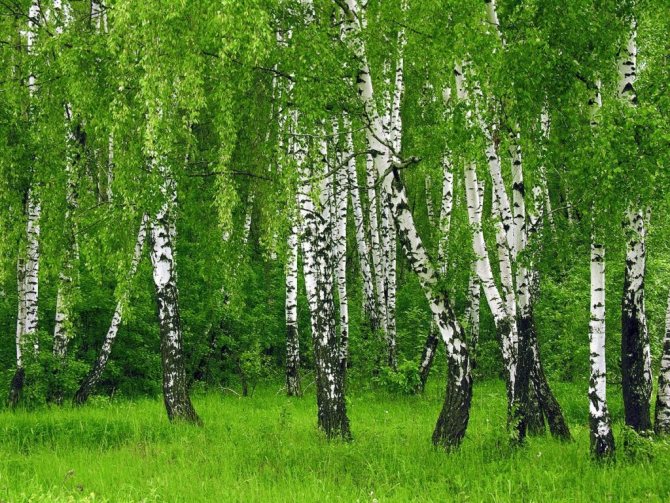

And that's not all, if birch grows near garden crops, then from the north it will create a shadow.Will it be convenient for you or your neighbors? Considering also the fact that the trees will begin to grow in width, it is necessary to observe the distance between each seedling. Therefore, we plant a birch every 4 m.
In addition, if you have not had time to pay attention, this tree does not like neighborhood with other cultures. If you look at a birch grove, then you will not see anything other than white birch trunks in it. This is another explanation that birch does not get along with other plants.
If your plot is small, think that as a result, only a beautiful birch grove will remain, and planting other plants and garden crops will no longer work. And not only because birch does not like to grow next to other crops, but also poisons the soil for neighboring plants, taking away all the nutrients and moisture.
You can admire the beautiful birch in the photo:
Choosing the right place
Birch is a rather unpretentious tree, but you still need to choose the right place for planting in your summer cottage. There are certain points to consider:
- The tree will grow in size every year. If all conditions suit him, then in height it can grow up to 30 meters. The trunk diameter is usually 50 cm.This means that you should not plant several birches too closely with each other, since they will interfere not only with themselves, but also with nearby plantings.
- And also there is no need to choose a landing site, which is very close to various communications and buildings. To choose the right place, certain requirements must be taken into account: there must be a distance of 5 meters between any buildings and a tree. You need to know exactly about all the underground communications that are located inside the yard. The tree should be located at least 3 meters from the nearest sewerage, drainage or water supply system. Ideal if the distance is even 5 meters.
- If tall trees "live" nearby, then birch should not be planted in this place.
- If there is a desire to create an alley and a kind of hedge, then all the seedlings should be located at a distance of 4 meters from each other.
It is worth knowing that birch will get along very badly near trees that require frequent watering. This is because, as it grows, the soil will become unsuitable for the comfortable growth of shrubs or other trees. The birch will pick up a large amount of moisture from the ground.
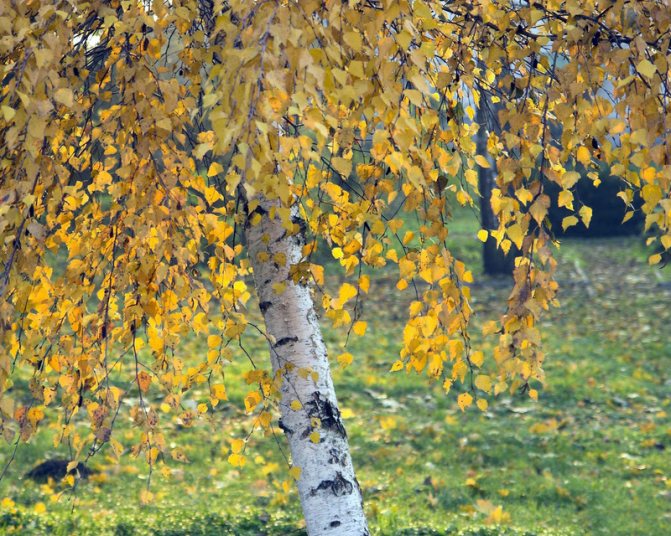

It will be best if you plant some kind of lawn grass near the plant, which will create an additional design of the territory. It is advisable to choose the eastern side of the site for planting birch. In this case, the necessary balance of shadow and light will be observed during the day.
Features of soil preparation for planting birch
If you look closely at the birch grove in the forest, you can conclude that the tree loves moisture and feels good on moist and cool soils. If you plant a tree in an open, sunny area, then even short dry periods can negatively affect the growth of birch. Therefore, it is necessary to think well and choose a suitable place for planting birch.
A completely shaded place for planting seedlings is not suitable, since the plant will gain strength and the green mass needs full lighting. Planting birch trees in shaded areas is allowed, but only halfway. Choose an area where, even in summer, the soil remains moist and cool, and the leaves should receive enough light and warmth during the day. A good place to plant a slender beauty is the north or east side of the house or any outbuilding. It is not recommended to plant birch trees on the west or south side so that the sun does not dry out the soil.
It is not recommended to plant trees along the road, the soil in this place is always dense and devoid of moisture.
If you have decided on the place, pay attention to the electric wires, after a few years, when the birch reaches a growth of up to 20 m, there is a risk that they may be damaged.
Returning to the quality of the soil, it is worth drawing the readers' attention to such a nuance - an adult tree is capable of pulling up to 200 liters of moisture from the soil per day, which is an average of 20 buckets of water. Can you imagine how much the soil around the birch will be dehydrated? It is possible that other garden crops will not have enough moisture. Given this feature of the tree, it is necessary to take care of the organization of watering the site in advance.
Adult birch pruning options
And what if you got the forest beauty in an adult state? There are several options here: if the size of the site allows, leave it as it is, and arrange a rest area under the birch. Knock down a bench around the trunk, hang a hammock, or set up garden furniture. In such a place, you will be cool even in the heat. A children's room for girls will perfectly fit under the canopy of foliage.
A cool twilight reigns under adult birches all summer long, so they hang hammocks, put swings and sun loungers, or equip a children's corner
The second option is to give the birch a more decorative look. It is used by those summer residents who plan to create a more orderly landscape, with trimmed ornamental shrubs, lawns, paths, etc. In this case, the birch can be beautifully pruned:
- Leave the branches only in the upper part, cutting off the top of the head and all the side branches growing below. This version of the haircut is called "under the palm tree", since this tree has all the leaves coming out of one point of growth.
- Cut off all the branches and the crown, leaving 10 cm from the thick branches on the trunk (imagine how many brooms you will tie at once!). Then, after a couple of years, the birch will be covered with a large number of young twigs extending from the stumps left, and will resemble a kind of green column.
Be prepared that not every mature tree will withstand such a shearing. A birch can be sick for a couple of years until it goes from shock. Another disadvantage of cutting adult trunks is that the roots will instantly give growth. So the birch is insured against death and shoots out new "offspring". True, it is not harder to deal with them than with a plum or cherry overgrowth.
To rid the area of extra shade, the branches of birches are completely cut down almost to the very top of the head (haircut a la palm tree)
How to take a birch sapling in the forest
Not everyone has the opportunity to go to the nursery and buy a young birch tree, it can be troublesome and costly. Another thing is to go to the forest and find a suitable option. If you want to grow a white-trunk birch from a wild forest in your summer cottage, then you need to dig out a healthy, strong seedling. Go to the forest in early spring, when the leaves on the birch have not yet blossomed. It is possible to find a suitable young birch in the fall, but it is undesirable to plant a tree in winter, since the birch may not take root.
Walk along a birch grove - choose a medium-sized game, no more than 1 m in height, since tall trees do not take root well.
How to properly dig up a seedling:
- With a shovel, you need to dig in a place around the young birch so that the roots are not damaged. Birch is not too capricious and tolerates minor damage to the root system calmly, but it is better to do this work as carefully as possible.
- Deepen the shovel code root from 3 sides, and then carefully and with pressure remove the tree from the ground. It is best to work in pairs, so you can dig up a good seedling without damaging the roots.
- You will need a thick plastic bag or bucket. It is necessary that as much soil as possible remain on the roots of the birch. Together with the ground, we place the birch in a bag or bucket, tie it with a rope and transport it to the transplant site.
What plants can live under a birch?
Since the land under the birch will be very dry, not all ornamental plants will be able to survive in such conditions. True, in the heat you still have to water (like any flower garden!).
Here's what the list of cultures looks like that can get along with a forest "guest":
- Strawberry
... Bring a couple of bushes from the forest and plant them right in the grass. It is much more interesting for children to collect such berries, to pick for weeks in the garden. - Bulbous
... These droughts are not afraid, as they bloom in early spring, when there is enough moisture even under the birches. And in the summer you will already dig them up. - Ferns
... A species of plants that is very resistant to any climate conditions. They will braid all the space under the birch, if you give them free rein. - Lilies of the valley
... Like the previous plant, they cover the soil with a dense carpet, not at all suffering from shade and dryness. - Anemone (or anemone).
It blooms all May and looks organically under a forest tree, as she herself is a native of the forest.
As you can see, most of the plants that can "make friends" with birch are forest dwellers. You may not even buy at the market, but go into the forest and "smuggle" up a lot of the necessary sprouts there. True, it is better to do this in early spring, so that the degree of survival is maximized.
Most often, plants of the spring flowering period are planted under birches, since they have enough moisture to form flower stalks after winter
How to plant a birch
The place for planting the birch has been chosen, the soil has been prepared (you can water this area well in advance). Now you need to purchase birch seedlings. You can go to the nursery and choose a suitable tree (age, thickness and height) or go to the nearest birch grove and dig out a young tree. If you brought a birch from the forest, then, most likely, this is a variety of the classic warty birch, which grows up to 20 m in height.
You can do otherwise and not make a big shade in your area, but choose a compact birch variety in the nursery. For example, among the low-growing varieties of the white-stemmed beauty, the Tristis variety is popular. A beautiful "weeping" crown with a non-blackening trunk and sparse foliage is liked by many summer residents.
Several other types of dwarf birches are unpretentious and grow even in urban conditions: this is the weeping birch "Youngii". An adult tree grows only 8 m in height, the branches rush down, almost to the very ground. The birch resembles a dome shape, its trunk differs from other tree species (varieties "Lanciniata", "Gracillis", "Crispa") by a bright white trunk, peeling almost all year round.
The basic rule for the successful growth of birch is the correct planting of the seedling. It is necessary to choose a suitable day for the plant to take root and delight all year round. Therefore, it is impossible to plant birch on a hot summer day. The best planting period is the second half of October or early spring. At this time, a lot of moisture is retained in the soil, and the sun is no longer so hot. The optimum temperature for planting birch is + 10 ° C.
The tree does not always take root after planting, even if you take a large, strong seedling. The secret of planting is that you need to dig out a tree with a lump of earth or buy seedlings in small containers from the nursery so that the root system does not stay outdoors for a long time and does not lose moisture.
It is even allowed to plant a birch in the winter (the age of the seedling is 6-7 years), when the clod of earth is a little frozen, but this is only in rare cases. It is best to take care of planting in advance, so that by spring the seedling has time to take root and grow.
There are no special recommendations on the rules for planting birch, it is advisable to plant a seedling in the afternoon, in the late afternoon.
How to plant a birch:
- after choosing a place, it is necessary to dig a shallow hole with a shovel so that a lump of earth can fit and the roots are not damaged;
- feeding is not required, but the birch will be grateful to you if you put several shovels of leafy earth, peat, sand and humus in equal proportions in the pit.You can add a little of any complex fertilizer, especially if the seedling was brought from the forest;
- insert a seedling with a lump of earth into the center of the hole and gently grind it with soil;
- compact the earth around so that the tree does not tilt. If the seedling is thin, then you can make a support and tie a rope to the trunk. So the birch will not bend from the wind and will not fall.
Remember to water the birch tree after planting. It is necessary to provide moderate watering from time to time (during the dry summer period - abundant), until the birch takes root. In the future, there is no need to water the tree, a strong root system independently takes moisture and nutrition from the soil. By the way, within a radius of 3 meters, do not try to use the soil, planting even "hare" grass or flowers - the plants do not take root, as they die due to lack of moisture, and not all summer residents can provide constant watering.
If you followed all the recommendations, then the next year you can evaluate the result of your work and admire the beauty of a young birch tree.
How to contain the growth of a forest tree?
If the arguments "for" outweighed all the "cons" - plant boldly. Moreover, it is quite within the power of an inexperienced gardener to restrain the growth of a forest beauty. As a rule, small birches are brought to the site, up to a meter high, because small seedlings take root more easily. Decide immediately what height will be the most harmonious in your landscape.
As soon as after a year or two the birch reaches the desired height, cut off the top. So you will give an impetus to the growth of side branches, make the crown thicker and stop growth forever. Pruning is carried out in the summer and after leaf fall.
If a birch tree with several trunks has sprouted on your site, twist them together and tie them. In a couple of years, this tree will take on its original shape.
In the wild, there are common and weeping species. The latter do not grow above 20 meters. But if you want to find a sapling of a weeping variety in the forest, you hardly recognize it in appearance, since in "childhood" birches look almost the same. Look for mature plants growing nearby. The wind rarely carries a different variety over a long distance.
But if you come across an ordinary birch, you can turn it into a weeping one by hand. Cut off the top of the head, and bend the side branches, striving upward, and hang them on each weight (water bottles, pieces of iron, etc.). The main thing is not to overdo it with weight. You need to start with small weights, gradually increasing their weight. Then in winter the branches will not break and there will be no frost breaks.
To give the branches a certain direction, pins are driven into the ground (since the tent is fixed) and branches with weights are tied to them. For the winter, the place of contact between the rope and the branch must be wrapped with a rag so that the bark does not fray.
Taking care of the tree after planting
A young tree needs shading immediately after planting. You can provide protection from the sun with any covering material: burlap, plant branches, nettles and even any weeds. If you are using grass, then you need to cover the soil by lunchtime, and remove the dry forest in the evening.
In the first year after planting, fertilizer can be applied to the ground. Ammonium nitrate, mullein, and urea will do. For 10 liters of water, we take almost 2 kg of mullein, 20 g of urea and the same amount of saltpeter.
Pay attention to how the tree develops in the first few years after planting. Often young birches are attacked by tinder fungi. These parasites must be removed immediately, as the wood may be damaged. Larvae and May beetles love to feast on the young roots of the tree. To get rid of pests, shallow digging is necessary, during which it is advisable to manually select the beetle larvae.
Often trees are attacked by tube-worm beetles, which damage and eat leaves. If you notice these parasites, then the diseased leaves must be cut off, and the tree must be treated with chemical solutions.If you do not want to spray the area with poisons, then limit yourself to removing damaged leaves, which must be burned immediately.
Do you need pruning?
In ordinary birch, the crown develops evenly, so you do not need to cut branches unnecessarily. Some gardeners achieve good results, forming the crown of a tree even of an ordinary birch (it does not tolerate pruning). It is advisable to remove damaged and dry branches from the tree, and if necessary, when the tree reaches a large height, you can cut down excess branches. We do this only after the period of sap flow is over. Wounds on the tree must be treated with garden varnish.
Every year the value of birch is increasing, as it is possible to start harvesting raw materials useful for human health.
For the blank, you can use:
- Birch buds. The collection period is from early January to late March. To do this, the branches need to be cut, tied into small bunches and cleaned of debris;
- we pluck young leaves from the tree in May, when there is a sticky substance on them. Leaves must be dried in a ventilated and warm room. If the drying rules are not followed, then the quality of the leaves may be reduced;
- lovers of the Russian bathhouse need to start harvesting brooms for the bath in July, just the leaves will have time to bloom and grow;
- harvesting of birch bark (a thin layer of bark) for the manufacture of tues (a vessel for storing drinks), caskets and other birch bark products begins in late spring - early summer. With a sharp knife, you need to peel off the top layer of the bark, and then dry the birch bark well;
- harvesting birch sap - at the beginning of spring, until the leaves had time to bloom on the trees. In order to get sap from birch, it is necessary to make an incision with a sharp knife, up to 2 cm deep. Make a small hole with a drill and insert a tube through which the life-giving sap will flow into the vessel (any suitable container). After collecting the juice, the tube must be removed, and the hole must be closed with a wooden plug and covered with garden pitch. The collected juice is stored in a cool place in a glass container.
How to plant a birch, watch this video:
Birch
- a tree with which native spaces are associated, one of the symbols of Russia, a very common tree in the middle zone of our country. Most often we can meet
common birch (drooping, or warty -
Betula pendula syn. Betula verrucosa
).
But gardeners are often wary of
birch
, slowly start it on your site. Birch has a branched surface root system, the roots take a lot of moisture and nutrients from the soil, which negatively affects the plants around it. But even this problem can be easily dealt with by a correct, well-established
watering
and feeding. Ordinary
Birch
it is also quite tall, so you rarely see it in small areas.
However, for small areas, you can choose undersized species. For mixborders, rock gardens, rocky gardens, there are mountain shrub varieties or varietal dwarf birches. Perhaps it is worth experimenting with the unusual shapes of your favorite tree.
In addition, do not underestimate birch and consider it a purely decorative tree, because it is very useful. All its parts are curative, you can harvest birch buds, young leaves, birch catkins, extract medicinal birch tar from birch bark and drink the most valuable birch sap in spring. Birch brooms for a bath have already become classics. Besides, the bright yellow fall foliage and decorative bark of white, yellow, pink, black colors are so beautiful!
The birch tree belongs to the birch family of the genus birch. There are about 120 species in nature, many of which are adapted for our latitudes. Shrub and dwarf forms live less than tall ones.
The genus birch is subdivided into 4 groups.
- Albae Group - this group includes trees with snow-white bark or similar ones in a number of ways.Here is the common birch and its varieties, the size of which does not exceed 15 m; Karelian birch with unusual winding bark; flat birch; fluffy birch (has a rounded crown and snow-white bark); paper birch is a resident of the mountainous regions of North America, it has taken root well in our country, it has a pyramidal crown and peeling pinkish bark.
- Nanae Group - this includes dwarf birch species with small foliage and small growth (dwarf birch, spreading birch, lean birch, round-leaved birch)
- Costata Group - this section is the most decorative for a gardener, combining views from several cardinal points. Feature in dense wood of various colors (yellowish, black, cherry, white). The trunk is ribbed at the bottom, on the front of the leaf there are interesting "depressed" veins (ribbed birch, Daurian birch, iron birch, Erman birch, black birch, cherry birch, Japanese cherry birch, Medvedev birch).
- Acuminatae Group - includes tall large subtropical species with large foliage (Maksimovich birch, Jacquemont birch, useful birch, shiny birch).
Ornamental varieties are appropriate in small areas
If the planting of birch is still only in the project, there is time to think about whether you need a wild tree. On 4-5 acres, it is worth doing with cultivated, grafted varieties that do not grow above 3 meters, which means there will be fewer problems.
Jung belongs to dwarf birches, it is often grafted onto a stem, so such a plant is appropriate in any design of the territory
Most popular in landscape design:
- Jung's variety, whose crown resembles a lush asymmetrical umbrella, beautifully falling to the ground;
- variety Gracilis, distinguished by its straight trunk and weeping branches;
- Long Trunk variety, with a dazzling white trunk without a single black dot, large carved leaves and a falling crown.
With proper placement and care, birch will become the main attraction in your country house and the envy of your neighbors.
Many different trees are planted in Russia every year, and the most beloved of them is birch. This white-trunked beauty is a real symbol of Russia. How to transplant a birch correctly so that it takes root and begins to grow well? To do this, several simple rules should be observed, the first of which is that it is better to plant a birch in early spring, while the foliage has not yet started to grow, then the trees are provided with a high survival rate.
It is necessary to prepare in advance everything that is required for the transplant:
- bayonet shovel; - a strong peg 1.5 meters long; - bucket; - a large piece of cellophane; - a piece of synthetic twine to tie cellophane; - 1 meter of rope to tie the seedling to the peg; - clay; - water; - humus; - complex fertilizer.
Planting holes for trees measuring 60x60x60 should be dug on the eve of planting, in a well-lit place. In bright light, the birch will grow thick, spreading, with dense foliage. A mixture of humus, garden soil and a handful of fertilizer is poured into the dug holes by one third.
Saplings of paper, American, Dahurian and many other birches can be bought in nurseries, but the cheapest way to get saplings is to dig them up in a well-lit area. In large forest glades or forest edges, birch growth grows strong, strong, and you can find saplings of drooping, or warty birch. You need to choose plants with a height of no more than 1 meter - when they are dug up, the roots will be damaged less, and they will take root better.
From the trunk of the selected seedling, you need to step back 30 cm and dig in the ground around the trunk in depth on the bayonet of a shovel, trying not to damage the side roots. Then bury the shovel under the central root and, prying the roots with an effort, pull the seedling out of the ground. It is better to work with an assistant, otherwise you can break the young tree.
Dug out seedlings should not be left in the wind or sun - they can dry out quickly.The soil on the roots must be preserved so that the thin roots are not damaged. An earthen lump with roots is neatly laid on a cellophane film, wrapped and tied with twine. The seedling can then be placed in a suitable container or stowed in the trunk of a car and transported to the planting site.
You need to drive a peg into the corner of each landing hole, and in one of the holes you can make a clay chatterbox by diluting the clay with water until sour cream is thick. Before planting, each tree is dipped with roots in this chatterbox and placed in a prepared hole, into which a bucket of water was poured. When planting, the root collar cannot be buried - this will worsen the growth of the tree.
Then you can start pouring earth into the holes, slowly trampling it from the edges of the hole to the middle. When planting, one person should hold the tree vertically, and the other should cover the roots with earth.
When the hole is filled with earth and compacted, the trunk of the tree is tied to the peg with a rope, twisting it between the trunk and the peg in the form of a rope so that the trunk does not rub against the peg in the wind. After planting, the tree needs to be watered. Water the seedlings twice a week if there is no rain. It is necessary to ensure that the ground in the near-trunk circles is always loose, then moisture will penetrate well to the roots of the seedling.
The genus birch is very numerous and distributed almost all over the world - in Europe, Asia and North America. According to various sources, there are from 60 to 120 species of birch - there are undersized trees, shrubs and creeping trees. There are species with trunks of pink, yellow, cherry and dark brown color, with a smooth, scaly or ragged bark. Birches are undemanding to environmental conditions. As a rule, they are photophilous, but they tolerate partial shade. With a few exceptions, they are very winter-hardy, withstand severe frosts, do not suffer from sudden changes in temperature and frost. In landscape design, trees are planted as part of picturesque groups to create dense massifs, groves, alleys along roads or protective curtains. The most common birches will be interesting in a bouquet planting, and exotic species and decorative forms - in a solitary one, against the background of a lawn. Note that some birch species tolerate urban conditions better than other trees, and are very undemanding. Therefore, before buying, take an interest in their features. You can also just dig a small tree in the nearest forest and transfer the seedling to your site.
Before you start planting, you should know that birch is a rather "harmful" breed. The fact is that it releases substances that "poison" the soil for other plants. As you may have noticed, birches grow well with each other, but do not get along with other plants. If you have a small plot, then you should only plant a small tree. Real birch groves can only be afforded by owners of large suburban areas. At what distance should birch trees be planted from each other?
We recommend that you control the distance between trees with a tape measure. It should be at least 3-4 meters between each seedling.
In the forest, birch trees grow on cool, moist soil. Their very shallow root system makes them susceptible to even short periods of dryness or warming of the soil, so they do not thrive on hot, dry soils. Thus, it is necessary to try to select a location for the birch in a shaded area where the soil will be cool and moist. However, birches require full sunlight to grow well, or at least half of them. Choose a location where the soil will remain cool and moist, and the leaves of the tree should receive sunlight for most of the day. An excellent place to plant birch trees is the area on the east and north side of the house, where the building provides afternoon shade.Avoid planting birch trees on the south and west side, where the sun heats and dries the soil in the afternoon. The best time of day for finding and assessing a birch planting site is from mid to late afternoon. At this time, you should look for a suitable place.
Landing
I have ordinary birch trees dug out in the forest. But in the nursery, you can see and purchase various varieties, based on your preferences and site capabilities. Hanging birch, and all its known varieties, are decorative due to the unusual color of the bark and foliage.
In spring, many species of birch “dress up” in “earrings” and sticky green leaves, in summer their dense foliage pleases with rich greenery, and in autumn, snow-white or pinkish brown bark is bordered by neat golden leaves.
When purchasing tall trees, keep in mind that their resistance to wind is lower than that of medium-sized and dwarf forms. As a rule, tall representatives are prone to spontaneous self-seeding. But they live longer than shrub and undersized birch species.
It is believed that the birch should be planted in the fall and the tree should be young ("teenager" or "child"). Large mature trees take root extremely poorly when transplanted. In addition, there is a risk of root damage.
But you can plant it in early spring, a prerequisite in this case will be a good clod of earth on the roots and a relatively small age of the seedling (about 3 years). A birch about 7 years old can be planted in winter with a frozen clod of earth. Seeds can be sown both in spring and autumn.
The birch does not need special fertilization of the soil, but it will not be offended if you add leafy soil to the planting hole. Does not like the close occurrence of groundwater.
It is best to plant birch on the soil composition on which this species grows in nature, but it is also not critical (except for species growing in swamps). For example, common birch, white Chinese birch, far-Carlian birch, Daurian birch, rare in culture, Jacquemont birch grow on any soil.
Birch Maksimovich from about. Kunashir loves light soils, dwarf birch - peat soils and loams... The reaction of the soil can be from neutral to high acidity, even alkaline for the Maksimovich birch species.
Agricultural technology is the same as that of many fruit trees. The pit should contain the roots and when planting, fill it up above the root collar, when deepening on the roots, the mycorrhiza fungus dies, and with it the birch will dry out. Take the distance between plants at least 4 m for common birch.
When planting, pour over the roots. After that, the soil in the near-trunk circle can be mulched (dry soil, humus, peat), this will help to retain moisture. Birch is undemanding to moisture, but for better survival, young trees are best watered at first.
Botanical characteristics
This tree belongs to the Birch family of the Birch genus. The root system is very ramified, it needs enough nutrients and moisture. Therefore, gardeners are in no hurry to plant such a tree on their site, because then hassle with and, if there is little moisture, will be added.
And some varieties are quite tall. In addition to its own, the plant is very useful, almost all of its components have healing properties: buds, leaves, catkins, birch bark, from which it can be obtained with unique medicinal properties. This is very useful for our health. Birch brooms are a real classic. The largest area of distribution of this beauty is the middle zone of Russia.
Did you know?
Approximately one hundred and twenty species of birch are known. Almost all of them are accustomed to our climate. Tall species of these trees live longer than dwarf and shrub species.
The genus Birch is divided into four groups: Albae (with snow-white bark, height does not exceed fifteen meters); Nanae (); Costata (decorative species with multi-colored colors); Acuminatae (tall trees with large leaves).
Care
- Watering... Water until a young tree takes root, and in the future the birch will not even require this. The root system of birch is superficial, so anything else from ornamental plants grows poorly under it.
But this year I desperately decided to plant sedum ("hare grass"), daisies, viola on the place "captured" by the birch roots, although in previous years many plants suffered a fiasco. Even the rose hips could not cope with the lack of water and nutrients that are absorbed by the roots of the birch.
After planting, young trees are shaded for the first time, this can be done with plant branches, burlap, covering material, even tall weeds and nettles. In the evening, the shelter is removed, if it is grass, it dries up.
- Top dressing. The first years after planting, I fertilized my birches with mullein, ammonium nitrate and urea. Approximate ratio: for 5 liters of water about 900 g of mullein, 10-15 g of urea and 15 g of ammonium nitrate.
- Removal of parasites. You can often find a tinder fungus on a birch tree. It must be removed, otherwise damage to the wood cannot be avoided. May beetles and their larvae feast on birch roots, so the soil around the tree is dug shallowly, the larvae are removed. I often saw pipe-runner beetles on my birches, when they appear, young damaged leaves are removed and burned, the tree is treated with chemicals. I observed such parasites on my birches, but I cannot use chemistry because of the presence of children. Therefore, where possible, I remove damaged leaves.
Pruning. When and how to carry it out
You need to prune birch based on what goals you are pursuing. First of all, it can be:
- crown formation;
- sanitary pruning;
- reduction in the size of the crown or individual birch branches.
Based on this, it is determined when it is better to perform these manipulations and how to do it.
General recommendations, regardless of what purpose is pursued when pruning a tree, are:
- use clean and disinfected gardening tools;
- you can remove no more than twenty-five percent of the crown, otherwise the tree will be damaged.
Pruning, crown shaping
The figure below shows how the crown develops in common birch. Birch is extremely negative about pruning, although I know of cases when gardeners form the weeping crown of the common birch Yucca and shrub species, only thinning them a little.
My birches are completely different in appearance and the number of skeletal branches. Last year, after the end of sap flow, we cut down and covered with garden pitch many large branches on our tallest birch. They were dangerous for vehicles and gazebos in strong winds. It is recommended to cut dry branches in autumn.
The subtleties of using birches in landscape design
The appearance of the site is always a matter of pride for the owner. Therefore, in order to make it unique, various subtleties are used to create a unique design. Here is a patio, and all kinds of Yes, you never know what other nuances an amateur gardener can use to make his site stand out among many others!
One of these tricks is the choice of birch trees for landscaping. Its use when creating a landscape is very diverse and depends only on the imagination of the owner of the site. The trunk of a birch is slender and snow-white, so these trees will look great both in the form of small alleys planted along and through groves in a certain area of the territory or, if the area allows, a dense massif.
Procurement and collection of raw materials
It is no secret that birch is a storehouse of useful substances, properly prepared raw materials contribute to a positive result in birch treatment.
Subject to procurement:
- Kidney - early spring (January to March). The branches are tied in bunches and dried, after which the buds are threshed and cleaned of debris.
- Young leaves - early spring (May).The sticky leaves are collected and dried in a warm, well-ventilated area with diffused sunlight. Poor drying affects the quality of raw materials. Bath brooms are harvested closer to July, when the leaves will bloom and grow a little.
- Birch bark - peel off the top layer of the bark with a sharp object, and then dry it well.
- Birch juice - harvested in early spring, until the leaves bloom. The cuts are made about 2 cm deep. We make the holes with a small drill. After that we insert the "dorodka" cut out of the bottle. It is somewhat reminiscent of a tube without a top, through which juice flows into a bowl. When the collection is over, we plug the hole with a wooden stopper and cover it with garden var. We store the juice in a glass container in the refrigerator. You can also harvest the juice from the stump, only with less harm to the plant.
Glade and other decor options with birches in the country
Very interesting compositions in the country can be created from birches and conifers. For this purpose, it is best to use crops belonging to the sections Albae, Costata, Acuminatae and Nanae. Dwarf birches are also used to create alpine slides or Scandinavian decor, which is very popular in our country.
If you have to cut down an adult plant on the site, then the remaining hemp can be used to create garden benches and benches or decorate in a folk style. Among other things, the backyard area can be decorated with unique crafts or unusual garden decor items made of birch bark. This handmade is very successfully combined with almost any style and will be a great addition to garden figurines, sculptural compositions, as well as other small architectural forms.
Types of birch
- Dwarf birch (Betula nana) - comes from the forest of the European part of Russia, Western Europe and Western Siberia. In nature, it grows on poor soils of swamps and peat bogs. Birch is presented in the form of a deciduous shrub up to 120 cm high. It grows slowly. Seeds are stored for 2 months, then for reproduction they undergo stratification for about 3 months at a temperature of + 1 + 10 ° C. Germinate at a temperature of about +25 ° C. In the middle lane, it blooms in May.
- Birch Maximovich - differs in the largest leaves among birch species, the origin of the tree is Japan, about. Kunashir. The wood is very heavy, used in construction, exported under the name "red birch". Bark color: brown-cherry, white-orange, gray. Birch bark exfoliates well. Branches are dark cherry color.
- Hanging birch (ordinary, warty) - a tall tree with a spreading weeping crown and a straight trunk. Used in group plantings, tapeworms, alleys, groves. The bark is white, flaking. The bark of an adult tree at the bottom of the trunk thickens, with black grooves and cracks. Wood is widely used in various fields. Plantings of common birch strengthen the soil of ravines and river mouths. Refers to medicinal plants. Used buds, birch sap, leaves and pollen.
- Chinese white birch (Betula albosinensis) - This species comes from Western China. Under natural conditions it reaches 30 m, in middle latitudes - about 8 m. Used in groups, specimen, ordinary plantings. The bark of white birch from white to brown-orange or golden-copper color, exfoliates and twists into "curls". A bluish bloom can often be seen on the bark of young plants.
- Daurian birch - most often grows in nature in mountainous regions. One of the few species that can be propagated by cuttings. When processing green cuttings with root, survival rate is 99%. It can also be propagated by layering from young growth. But pruning is extremely negative. Bark color: black, dark brown with white specks, cracks along. The branches are pinkish-brownish, the crown is falling.Wood that is heavier than common birch will not grow on dense soils. The places where this species grows are rich for agriculture.
Where to order birch pruning at favorable prices?
Photo 4. Removing small branches.
If you do not know when you can prune birch in the fall or summer, how to do it correctly, contact the experienced arborists of the Lesmaster company for help. Our employees carry out all operations at the right time and in compliance with the rules for caring for this type of green space. Experts guarantee the safety of people and property when performing work.
To consult when it is better to prune birch, or to order our services, call the managers of the company by phone 8 or leave a request.
On private territory, in particular in the country, you can often find growing birches. This is explained not only by the specifics of the Russian climate, but also by the fact that they are distinguished by their unpretentiousness and attractive appearance - the light bark looks advantageous both in winter and in summer, which other tree species cannot boast of.
But even despite all the unpretentiousness of birches, they also need some care - crown and pruning (at least the tops), especially in spring and autumn.
Interesting varieties of common birch
- Joungii (Jung) - a fragile beauty has an asymmetrical crown in the form of an umbrella. Reaches 4 m in height.
- Trost's Dwarf - a slowly growing dwarf tree, reaches a height of about 1.5 m. It is distinguished by an openwork crown and gray-green foliage.
- Purpurea - the name of this variety speaks for itself. He fell in love with his purple foliage. In autumn, the shade of the leaves is from brown with a bronze overflow to red or bright red. Height up to 15 m, compact crown.
- Gracilis - this variety combines a white trunk with a delicate bark and a weeping crown. Such an unusual appearance will appeal to both connoisseurs of birch and admirers of weeping willow and its flowing branches.
Tell us, which birches did you like and grow on your plots?
Reasons for choosing when landscaping a birch plot
The forest beauty is especially preferable when creating a design in small areas, because the white birch trunk is simply created in order to visually expand the boundaries of the landscaped area. In addition, thanks to the openwork crown of this plant, the site takes on a festive look.
Excellent external data make white-trunk beauties undoubted favorites among the numerous types of trees used for landscaping the backyard. Here are just a few of them:
- Sliding shade from a high crown, which creates additional coolness on hot days and does not interfere with the growth of other plants. In addition, birch, planting and caring for which is not particularly difficult, seems to have been created so that numerous shade-loving crops that do not like excessive moisture grow next to it.
- Branches that descend to the very ground can play the role of a natural gazebo, which beckons to hide from the heat on a sultry afternoon. Rest in it will bring true pleasure.
- The gold of the autumn foliage of this tree will give the site a magical, fabulous look.
- Birch roots perfectly take away excess moisture and dry up the area in which this plant grows.
All this makes birch plantations desirable on many plots, the owners of which strive to create a magical, eye-catching uniqueness of their backyard territories.
Preparation of seedlings - what to look for
A young tree can be dug in the forest, transferred to your own plot and planted with a birch. This is the fastest and most inexpensive way. But to be sure of the quality of the seedling, it is recommended to purchase it in a specialized nursery or from trusted and reliable individuals.
Having brought a diseased seedling to the territory of the site, there is a high risk of spreading diseases to other trees and shrubs growing nearby.
As for the size, plants no more than 1 meter in height take root and adapt best of all. If the birch is already mature, it will be difficult to remove it from the ground without damaging the rhizomes.
If everything is clear with the purchase, then the process of digging and transporting a tree from the forest has its own nuances:
- 1. After a specific plant has been selected, it is dug in from all sides, and then with the help of a bayonet shovel, cut through the soil and uproot the rhizome, taking it out of the hole along with an earthen lump.
- 2. The removed birch must be immediately placed on a prepared plywood or other flat surface for transportation. If you have to cover a long distance, it will be convenient to use a bucket of a suitable size instead of a flat sheet. It is advisable to sprinkle the tree placed in the container on top with earth in order to completely cover the root processes with it.
There is another way of harvesting material for growing birch - planting from seeds. The matter is very laborious and takes time, however, and such a method takes place.
Growing birch from seeds
The seeds ripen inside the birch catkins, which the plant releases in spring. Over time, they turn brown and, after full maturity, scatter in search of a germination site.
The seeds, completely ready for planting, are easily separated from each other if you rub the earring in your hand.
Seeds are usually collected at the very end of summer or early autumn. Ripe earrings are collected, tied together in bunches and hung in a dark, warm place until further ripening for about a week. After this period, you can spread a white cloth or sheet under them and shake out the seeds on it.
In indoor conditions, birch germinates quickly and easily, without causing trouble. However, in order to protect the planting material from being damaged by the fungus, it is recommended to pickle it with potassium permanganate or hydrogen peroxide before placing it in the ground. The seeds should be in the solution for about 15–20 minutes, and then they should be thoroughly dried.
Before sowing in open ground, the planting material must also undergo a stratification procedure - cold treatment. For this purpose, the seeds are kept in a refrigerator or cellar for about a month.
The very process of planting seeds is simple. The procedure is carried out directly on the surface of the soil at the beginning of winter, when the soil has already had time to freeze. This is important, as early sowing in a still warm soil can promote the emergence of sprouts before severe frosts, and this will lead to their death. It is recommended to cover the place from above with planks to prevent the spread of seed to unwanted areas of the yard or garden.
If the autumn turned out to be dry, then the planted seeds should be lightly watered with water at room temperature.
If everything was done correctly, then in the spring, small sprouts of birch will appear at the planting site. At this time, the plant is most vulnerable, it needs to moisten the soil surface, but is afraid of excessive watering. Water is capable of eroding roots located at a depth of 7–10 centimeters, so it is more convenient to abundantly spray small birches from a spray bottle until the very end of the summer season.
By the beginning of autumn, with good care, young birches reach a height of 25–35 centimeters and can be transplanted to a permanent growing site. If the plants still look weak, then the process is postponed until next September, when the crops finally take the form of strong seedlings.
Winter beauty
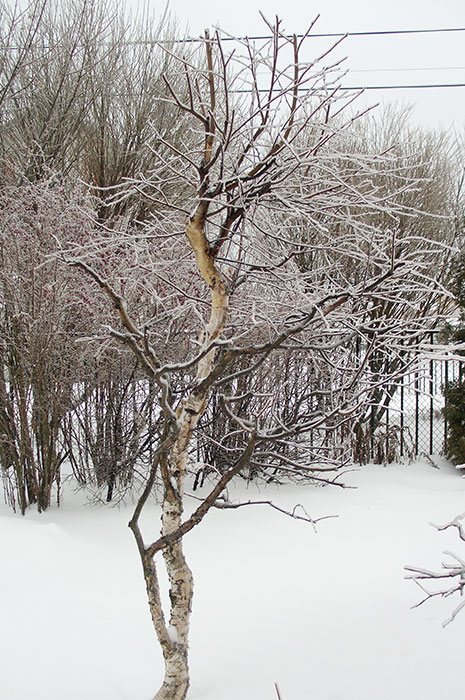

In winter, birches always attract attention, especially when formed
In winter, we see only the "skeleton" of birches. It is during this time of year that the whimsical curves of garden bonsai draw attention. True, all the flaws are more noticeable than in the summer under the foliage.
Many people remember the freezing rains, which caused a lot of troubles. They did not spare the birch either. Garden bonsai under the ice crust not only did not suffer, but also looked more spectacular.


The freezing rain did not damage the strong birch trees with a formed crown. Big trees in forests and parks he did not spare
40

